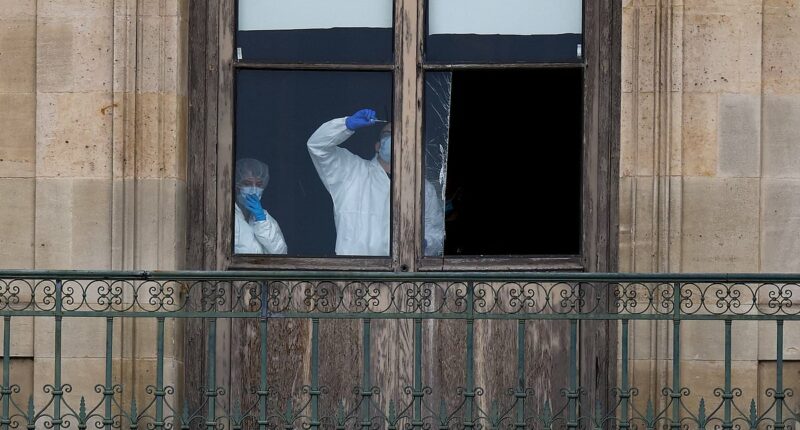Share this @internewscast.com
An audacious daylight robbery unfolded in central Paris on Sunday as four thieves, cleverly disguised as construction workers, executed a heist at the Louvre Museum, making off with over $100 million worth of jewels.
The daring theft occurred at 9:30 a.m. when two of the culprits, wearing yellow vests and masks, used a truck-mounted ladder to reach a second-floor balcony of the Apollo Gallery.
Equipped with an angle grinder, they shattered a window, setting off the museum’s alarm system. Undeterred, they smashed open two display cases housing Napoleonic jewels and crowns. In a matter of minutes, they seized nine valuable pieces and made their escape down the ladder, fleeing on scooters along the Seine River.
The entire heist was over in less than seven minutes. Among the stolen treasures are a royal sapphire necklace, an emerald necklace complete with matching earrings, and a diadem once adorned by Empress Eugénie, wife of Napoleon III.
In their haste, the thieves also attempted to snatch a diamond-encrusted crown belonging to the Empress, but it was dropped during their escape. Fortunately, it was later recovered on the street, slightly damaged but not beyond repair.
French authorities are now in a race against time to track down and capture the ‘highly organized’ group. Retired FBI agent Geoffrey Kelly remarked to the Daily Mail that the pursuit of these thieves is both urgent and critical.
Kelly, who investigated the 1990 Gardner Museum heist in Boston – the largest art theft in history – said the fate of the jewels, and the likelihood they’ll be recovered, now depends on how quickly the police can close in.

French police officers stand next to a furniture elevator used by robbers to enter the Louvre Museum in Paris, on October 19, 2025

Empress Eugenie’s tiara (pictured), created by Alexandre-Gabriel Lemonnier in 1853, was stolen
If the thieves feel the pressure, he said, they’ll likely enter a ‘cooling-off’ period – hiding the jewels and keeping them intact as a potential bargaining chip if they’re arrested.
But if they believe they’ve gotten away with it, that’s when the dismantling begins – the gems recut to disguise their origins, the settings melted for raw gold, and the stones quietly sold off in batches to unscrupulous dealers.
Once that happens, the pieces are effectively erased from history – impossible to trace or recover, their symbolic value lost forever.
‘I’m hopeful there’s going to be a cooling-off period,’ Kelly told the Daily Mail.
‘If you’re smart, you hold onto them for a while. Because if the French police track you down and come knocking, you want some kind of bargaining chip – something you can give up in exchange for a bit of clemency.
‘But if you’ve already broken down Napoleon’s incalculably valuable jewels, you lose that leverage.’
Breaking down the jewels is where the real work begins – and is perhaps riskier than the theft itself. Transforming priceless pieces into something untraceable requires time, skill and contacts willing to take enormous risks.
‘You’d need at least a few skilled jewelers to do that,’ Kelly said, noting that the process will involve cutting down around 8,000 stones and melting gold settings for resale.
‘If somebody was asked to do it and said no, that’s a potential witness,’ he added. ‘And that’s a problem.’

Thieves also got away with an emerald necklace, pictured, from the Marie-Louise set made by master jeweller François-Régnault Nitot in 1810

The gang also took a sapphire jewellery set of Queen Marie-Amélie and Queen Hortense. It was made in Paris between 1800 and 1835

The tiara, pictured, from the jewellery set of Queen Marie-Amélie and Queen Horten that was made in Paris in the 19th century, was also taken

The Crown of Empress Eugénie (pictured) was stolen but found discarded and damaged shortly after the heist

Retired FBI agent Geoffrey Kelly was the lead investigator of the Gardner Museum Heist
More than 100 investigators are working around the clock to identify the Louvre thieves, poring over hours of surveillance footage and forensically analysing the tools and other materials left behind.
Among the items seized were two grinders, a blowtorch, gasoline, gloves, a walkie-talkie and a blanket. The thieves also failed to burn the truck used in the break-in, giving police another key lead to examine for DNA.
On Tuesday, investigators recovered one of the two scooters used in the getaway, along with a helmet believed to have been worn by one of the culprits, CNN reported.
French authorities have also enlisted the help of Interpol, widening the search beyond France’s borders amid fears the jewels may already have been moved across Europe.
Kelly said the sophistication of the operation leaves little doubt that this was no amateur job. He believes the heist bears all the hallmarks of a professional crew, likely backed by organized crime.
In his experience, such teams spend weeks or even months casing a target, identifying weak points, and rehearsing every movement before striking.
Despite its reputation and extensive security staff, Kelly said institutions like the Louvre are often far more vulnerable than people assume.

One of the suspected thieves was filmed as the group raided priceless jewellery that once belonged to Napoleon and his family

Investigators are seen gathering evidence left behind by the thieves, including the grinders used to force their way into the museum

Investigators have been casing the crime scene for DNA
‘It’s a problem when you have a museum that’s three or four centuries old,’ he said. ‘They’re not built to the security specifications of a twenty-first-century institution.’
Because of that, he explained, there are always blind spots – areas where it’s difficult, or even impossible, to install modern systems without damaging the structure itself.
‘You have a museum where the building is a piece of art,’ he said. ‘Security directors want to put cameras in certain places, but curators push back because it means drilling into frescoes or eighteenth-century paneling.’
The result, Kelly said, is a constant balancing act between preservation and protection – one that can leave even the most famous museums exposed.
But no crime is perfect, and the global attention the heist has attracted will force authorities to act fast – and aggressively.
Kelly believes the breakthrough will come from DNA, noting that modern technology now requires only a tiny sample to find a match.
He warned that if the Louvre thieves aren’t caught soon, their success could inspire copycats.
If they are, their arrest will act as a strong deterrent to other would-be criminals, Kelly said. But if they aren’t, at least in the short term, he believes other offenders will see their smash-and-grab tactics as ‘a good way to make money.’
Identifying the thieves would solve only part of the problem; recovering the jewels could prove an entirely different struggle.
That, Kelly warned, could take years – if it happens at all.

The thieves were unable to burn the truck they used in the caper, potentially leaving behind crucial traces of DNA

Police transported the elevator used by robbers to enter the Louvre away from the scene

The Gardner Museum Heist is the largest unsolved crime of its kind in the world. In that case, two thieves made off with $500 million worth of art
He pointed to the Gardner Museum case, which remains unsolved more than three decades after two men posing as police officers stole $500 million worth of art.
The FBI announced in 2013 that they believed they’d identified the culprits, who have since died, but the stolen artwork’s whereabouts remain unknown.
While Kelly believes the works may one day be recovered, it could take generations. He added the loss extends beyond the value of the stolen works themselves – or in the case of the Louvre, the stolen jewels.
‘These are tangible representations of our cultural heritage,’ he said. ‘When you take them away, you diminish our history a little bit.’
He added that the theft was not just a crime against France, but against all.
‘It’s a loss, not just for the Louvre or the people of Paris,’ Kelly said, ‘but really for all of mankind, because Napoleon was part of our world’s history.’
None of the jewels stolen during Sunday morning’s heist were privately insured, the French government revealed.
That’s because French law prohibits entities like the Louvre from insuring its property, except when part of a collection is moved or loaned to another institution.
‘Everything that belongs to state museums in France is uninsured, unless it leaves the museum,’ Romain Déchelette, the president of fine art insurer Serex Assurances, told CBS News.
The museum reopened its doors to the public on Wednesday.





